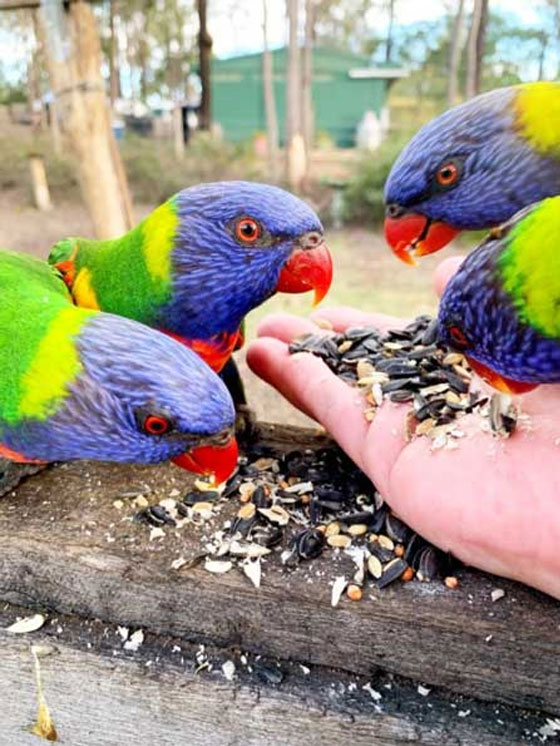

Overview of the Rainbow Lorikeet
South East Queensland is renowned for its rich biodiversity, and among the many remarkable bird species that call this region home, the Rainbow Lorikeet (Trichoglossus haematodus) stands out as a true icon. With its vibrant plumage, playful nature, and raucous calls, the Rainbow Lorikeet is a beloved and easily recognizable bird, adding a burst of color and energy to the avian tapestry of South East Queensland. One of the highlights of visiting Murphys Creek Escape is the chance to feed Rainbow Lorikeets (Trichoglossus haematodus), a colorful and sociable species of parrot that frequents the area.

Physical Characteristics:
The Rainbow Lorikeet is a medium-sized parrot, measuring about 25 to 30 centimeters in length. Its feathers exhibit a kaleidoscope of colors, with a predominantly bright green plumage adorned with splashes of blue, yellow, orange, and red. Its beak is curved and sturdy, perfect for feeding on nectar, pollen, and soft fruits. The lorikeet’s feet are adapted for climbing and grasping, allowing it to maneuver skillfully through tree canopies.
Habitat and Distribution:
Rainbow Lorikeets are widespread throughout South East Queensland, thriving in a variety of habitats such as rainforests, woodlands, parks, and urban areas. They are highly adaptable and can be found in both natural and human-altered landscapes. Their distribution extends beyond Queensland, encompassing coastal regions from northern Queensland down to eastern Victoria and even parts of Indonesia.
Diet and Foraging Behavior:
Rainbow Lorikeets are nectarivorous birds, meaning their diet primarily consists of nectar from flowers. They possess a specialized brush-like tongue that allows them to extract nectar efficiently. In addition to nectar, they also feed on pollen, soft fruits, seeds, and insects. You may often observe them hanging upside down from branches or clinging to flowers as they feed.
Social Behavior and Calls:
These gregarious parrots are highly social creatures, often seen in large flocks that fill the air with their energetic chatter. Their loud and raucous calls, a mix of screeches, squawks, and whistles, can be heard from a distance. Rainbow Lorikeets are known for their playful antics, engaging in acrobatic displays, and engaging in social interactions such as preening and feeding one another.
Breeding and Nesting:
During the breeding season, Rainbow Lorikeets form monogamous pairs. The female selects a suitable tree cavity or nest box, where she lays her eggs and incubates them. Both parents participate in raising the chicks, taking turns feeding and caring for the young until they fledge. The communal nature of their breeding colonies adds to the spectacle of these vibrant birds.
Conservation Status:
Rainbow Lorikeets are not currently considered threatened and are listed as a species of least concern by the International Union for Conservation of Nature (IUCN). Their adaptability to various habitats and ability to thrive in urban areas have contributed to their population stability. However, habitat loss, introduced predators, and the illegal pet trade pose ongoing challenges to their long-term conservation.
Where to Spot Rainbow Lorikeets in South East Queensland:
Rainbow Lorikeets are a common sight throughout South East Queensland, from suburban gardens to parks and nature reserves. Some notable locations for observing these colorful parrots include Noosa National Park, Brisbane Botanic Gardens, and Currumbin Wildlife Sanctuary. Look for their vivid plumage and listen for their distinctive calls to locate them amidst the foliage.
Tips for Birdwatching Rainbow Lorikeets:
- Bring binoculars or a camera with a zoom lens to observe the lorikeets up close and capture their vibrant colors.
- Look for flowering trees and shrubs, as these are the primary food sources for Rainbow Lorikeets.
- Visit during the early morning or late afternoon when the lorikeets are most active and vocal.
- Be patient and observe their behavior, as you may witness their playful interactions and feeding rituals.
The Rainbow Lorikeet is a testament to the diverse and captivating birdlife of South East Queensland. Its vibrant colors, social nature, and lively calls make it a beloved and charismatic species. As you explore the natural wonders of this region, keep an eye out for the Rainbow Lorikeet’s dazzling presence, and let its beauty and vibrancy remind you of the remarkable avian diversity that enriches South East Queensland.
Read More: Birdwatching at Murphys Creek Escape
